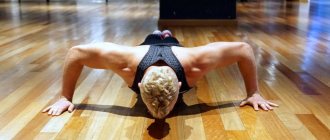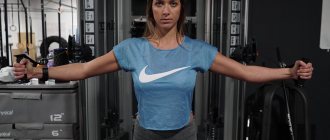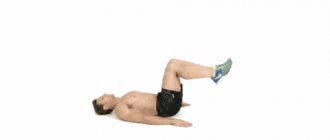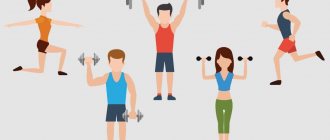About classes on the horizontal bar
The horizontal bar is a universal sports equipment for men. With its help you can pump up your latissimus back, pectoral muscles, as well as biceps and triceps. Perhaps the main advantage of the horizontal bar is its accessibility - the crossbar can always be found at the nearest sports ground or school stadium, and nothing will prevent you from installing it at home, on a balcony or even in a doorway. Many men, with the help of exercises on the horizontal bar, manage to build up an ideal athletic body, with broad shoulders, strong arms and developed muscles of the shoulder girdle.
The secret to the effectiveness of exercises on the horizontal bar is working with your own weight. But if at some point your own weight becomes insufficient, you can always add weights in the form of a special vest with sand or weights on your arms and legs.
By exercising on the bar you can strengthen large muscle groups. Essentially, horizontal bar exercises develop your entire upper body and abs.
Variability of exercises on the horizontal bar
Chest exercises on the horizontal bar depend on the size of your grip:
- wide, this is when the palms are wider than the shoulders;
- medium – at shoulder level;
- narrow - narrower than shoulders.
Alexander Shestov
TRX Certified Trainer
Ask a Question
If you have insufficient practice or lack of strength to do pull-ups, you can ask another person for help, which will involve lifting over the bar, as well as descending from the machine.
Simple/natural grip
- palms are placed at a distance equal to shoulder width, facing outwards;
- bending the elbows is possible while exhaling, lifting is carried out until the chin is placed above the bar;
- moving down is accompanied by relaxation of the arms, and you also need to take a breath.
For the first workout, 3-5 pull-ups are enough. In the future, you can perform 15 repetitions in three approaches.
Return grip
This is an effective workout of the pectoral muscles, which has a high-quality effect on the biceps, as well as the broad muscles of the back. Using the reverse method, you can pump up the small and pectoral muscles. When performing the exercise, you need to be especially careful about the tension in the chest area.
Technique:
- Place your arms slightly narrower than your shoulder span, palms inward;
- bend your legs at the knees, cross your ankles;
- You need to exhale when going up, and inhale when going down.
It is necessary to rise and lower with full power, as high and low as possible, the task using the return grip is easy. When doing pull-ups this way, it's the greater number of attempts, not the approaches, that matter.
Symmetrical grip
An exercise on the horizontal bar for the pectoral and other muscles of the upper body, performed in this way, can be considered an additional activity in the training complex.
Technique:
- the starting position assumes a narrow placement of the palms, but without discomfort;
- when lifting, you must touch the bar not with your chin, but with your chest;
- the downward movement is short;
- You need to perform the exercise correctly using your biceps.
Bulky grip
The main difference is when you touch the bar with the back of your head and not your chin. With this performance, the load falls on the broad muscles of the back. To pump up the chest, you need to touch the crossbar with your chest.
An excellent result in building muscle mass is obtained by combining this exercise with a bench press. It is important to perform the task correctly, controlling your breathing.
Technique:
- Place your hands at a distance equal to shoulder width;
- you need a deep breath, tensing the muscles of your back and chest;
- pulling the chest towards the crossbar is performed while exhaling;
- elbows remain in a stable position;
- As you exhale, you need to smoothly lower down.
Limited grip
It is this option that has the greatest effect in pumping the arms and chest. The load on the target muscles can be increased by bending the torso forward and moving the legs back. To perform the exercise, you can use a natural or reverse grip.
Technique:
- the grip on the crossbar is performed with a distance of 10-20 cm between the palms;
- the muscles of the arms and chest are tense;
- pulling up is performed while inhaling, the crossbar must be touched with the chest;
- the body lingers in the position, but literally for a second;
- return down is slow.
Pull-up methods
Pull-ups are a basic exercise with basic technique. It is available to absolutely every man. Difficulties can arise only in people who are significantly overweight. There are several execution techniques.
The main nuance is the width of the grip or positioning of the hands; the distribution of the load on different muscle groups depends on this. Types of hand positioning (grips):
- medium (classic);
- wide;
- narrow;
- back;
- combined.
Classic pull-ups are performed with a medium grip, with your hands positioned directly under your shoulders. The grip is straight, that is, with your fingers away from you. This technique uses the latissimus dorsi and biceps.
Wide straight grip - hands positioned 1.5 shoulder width apart, fingers facing away from you. This method works the upper back, but the chest is practically not involved during execution.
Those who are interested in what grip to do pull-ups to pump up their pectoral muscles should master the technique of performing with a narrow position of the arms. The distance between the brushes is about 10-15 cm.
A reverse grip, when the hand is placed on the bar with your fingers facing you, primarily loads the biceps. Combined – this is for real fans of working on the horizontal bar. With this technique, one hand is positioned with a direct grip, the other with a reverse grip, but the distance between the hands can be any.
Tips for working on the horizontal bar
- With the correct grip, the forearms at the top point are perpendicular to the floor and parallel to each other. This allows you to achieve good load and amplitude.
- You need to lower and pull yourself up to the end. At the top point, the chest should touch the horizontal bar.
- At first, you can ask someone to push. This will slightly reduce the load and increase the number of repetitions.
You now know how to pump up your pectoral muscles on the horizontal bar. There is nothing difficult if you have perseverance and the desire to achieve results.
So which pull-ups are effective?
Bad news for horizontal bar followers: it is impossible to fully pump up your chest on the bar. The mechanics of movement on the horizontal bar is the tension of the biceps and latissimus dorsi. Some execution techniques additionally involve the rear or front deltoids and trapezius. In general, the essence of the exercise is to stretch your own body with the help of your arms and back, so the chest practically does not work.
The back muscles work at the moment of extension, as evidenced by all sorts of rows performed on exercise machines, but the chest is structured differently. You can force the pectoral muscles to contract and stretch (this is what pumps them up) only with the help of a bench press. This area works when pushing something away from the chest. Under the “something” there can be a barbell, dumbbells, or your own body. Therefore, the only effective method of training the chest without additional equipment is push-ups.
However, the opinion that the chest can be pumped up on the horizontal bar is not entirely wrong. You can get this area to work a little, but your pull-up technique will have to change.
So, how to do pull-ups to pump up your pectoral muscles? The algorithm is as follows.
- Place your hands on the bar so that there is a distance of no more than 15 cm between them. Grip straight; it is recommended to pre-treat your hands with talcum powder so that the bar does not slip, or use special gloves.
- Lean your body back and move your legs forward. For better balance, you can cross your ankles.
- Pull your body so that the bar is at the level of your collarbones. In the upper position, tilt your body back as much as possible and stretch your legs in the opposite direction. Then smoothly lower your body, returning to the starting position.
It will not be possible to effectively work out the chest in this way, since pulling up only uses the uppermost bundle of the pectoralis major muscle. The load is distributed to a greater extent on the biceps. If you do only this exercise, over time you can pump up impressive biceps and only slightly tighten your chest. The outlines of the chest will become more noticeable, but only in the upper part, but such an exercise will not give relief or volume.
Subtleties of pumping up the pectoral muscles on the horizontal bar
The simplest and most well-known exercise machine is the horizontal bar. With its help, it is possible to pump up all muscle groups, the pectoral muscles are no exception. You may notice that chest pull-ups are not the most effective option for pumping up the sternum, since with this exercise the chest muscles will be the last to be used. But despite this, this exercise should be performed as an additional exercise.
Important! All exercises for the pectoral muscles on the horizontal bar should be performed as carefully as possible, without sudden movements, smoothly. Proper breathing also plays an important role - it should be slow, you should exhale when relaxing.
Load control is fundamental when performing chest pull-ups on the horizontal bar:
- there is no need to strive to perform the maximum number of pull-ups in one approach;
- it is better to increase the number of repetitions when the technique is perfected;
- Gradually the muscles will get used to such loads, and therefore they need stress. In such a situation, during training you will need to add a load in the form of a heavy backpack or several weight plates.
Several types of hand grip: 1 - reverse, 2 - straight, 3 - mixed. When changing, the load changes
While performing the exercise, you need to change your grip, which comes in three types:
- wide - arms should be placed as wide as possible. The back muscles work to a greater extent;
- narrow. Designed to work the chest muscles;
- average. Works equally on the back and chest.
The video shows exercises on the horizontal bar that will help pump up your chest.
Important! The level of muscle load is directly dependent on the choice of grip. At first, it is better to start with a minimum load. When doing pull-ups with a wide grip, the maximum load on the back is achieved, and the smaller the grip of the hands on the horizontal bar, the better the chest muscles will be worked.
When performing a pull-up, it is possible to increase the load on the sternum by deflecting the body and moving it forward. Initially, you should do three sets of 15 repetitions.
How to pump up your chest: push-ups and presses
Having understood the features of the target zone, it becomes clear that voluminous breasts cannot be formed on the horizontal bar. The following exercises will help pump up this area:
- push ups;
- barbell or dumbbell press;
- bench press;
- raising hands;
- Svend press.
These four exercises can create a very effective chest workout that is suitable for both beginners and experienced athletes. Classic techniques are recommended for beginners, while those with sufficient experience can complicate the execution in many different ways.
- You should start with push-ups. This is a basic exercise, after which the muscles are quite tired, but in general they are still capable of further work. The main question is what grip to do push-ups to pump up your pectoral muscles. To develop this area, the arms must be placed as wide as possible, that is, there should be a distance between the hands equal to one and a half shoulder widths. It is with this positioning of the arms that the pectoralis major muscle works. Other nuances: lower yourself almost until your nipples touch the floor, your elbows should not “walk” to the sides. The downward movement is smooth, the body should be pushed up with maximum force.
- The press of any apparatus is the second basic exercise for the chest. You can use a barbell or dumbbells. If you don’t have anything at hand, even an ordinary barbell will come to the rescue, although holding it in your hands is inconvenient. To work the target zone, the press is performed lying down. The weight is used about 80% of the maximum, no more is needed, otherwise you will not have enough strength to complete the workout.
- The chest press is suitable for those who work out in the gym. It is recommended to use an incline bench - this will allow you to focus on the middle and lower chest. In essence, the movement is reminiscent of working with a barbell or dumbbells, but much simplified.
- The Svend press will help “finish off” the area being worked. This vainly forgotten exercise is a bench press of one plate held between the palms. Performed while standing.
- It is recommended to finish the workout by lifting your arms with dumbbells (lying) or doing a butterfly bench press. Both exercises effectively stretch the pecs.
All of the listed exercises should be performed in 3-4 sets of 10-15 times, depending on the form.
Is it possible to pump up your chest on the horizontal bar?
Can. But don’t rush to grab the bar and fly up. There is one serious nuance here: this can only be done in combination with other exercises. Simply by doing pull-ups, you strengthen the muscles of your arms and back, which is very useful, but if your goal is beautiful breasts, then don’t get hung up on just one bar. If you have just now decided to take control of your body and achieve sculpted muscles, then start with the following exercises:
- push-ups (from a bench, from the floor, on parallel bars, from a bench from a rear position);
- lying dumbbell flyes;
- bench press
How else to use the horizontal bar?
If all the dumbbells and barbells in the area have disappeared, and the gyms are closed for renovations, you can turn to a workout and remember the horizontal bar and uneven bars. With the help of these simple sports equipment you can really effectively work out the body, add volume and relief to the muscles.
An approximate training program for working out the whole body in a regular sports field:
- wide grip pull-ups – 3 sets maximum of times;
- wide grip push-ups – 3x20;
- pull-ups with a narrow grip with body deviation - 3x20;
- parallel bars push-ups – 3x15;
- “diamond” push-ups – 3x10;
- lifting legs while hanging or supporting – 3x20.
This simple workout is suitable for beginners and people who want to stay fit in any conditions. A balanced diet and adequate alternation of training and rest will help speed up muscle gain and improve body contour.
Dips
Power-ups, like pull-ups, are not ideal exercises for the pectoral muscles. If you train on outdoor equipment, we recommend doing push-ups. This element is best suited for working the lower chest. Let's look at the technique:
- We grab the edge of the bars, jump slightly and perform a handstand.
- We spread our elbows to the sides.
- We lower our chin to our collarbones, bend our knees so that our thighs are parallel to the ground and “round” our back.
- We fix this position and begin to smoothly do push-ups.
- It is advisable to perform the exercise on wide bars; on narrow bars, the triceps will be actively involved in the work;
- in the upper phase, do not straighten the elbow joints completely, otherwise the load on the chest will subside;
- We control all movements, avoid sharp jolts, swaying of the body and “throwing” the body down.
The exercise is performed for 3-4 sets of 10 repetitions each.
The last 2-3 push-ups in a set should be difficult. If this does not happen, it is necessary to increase the load with weights. For example, you can use soft weights on your legs or throw a backpack full of books over your shoulders.









